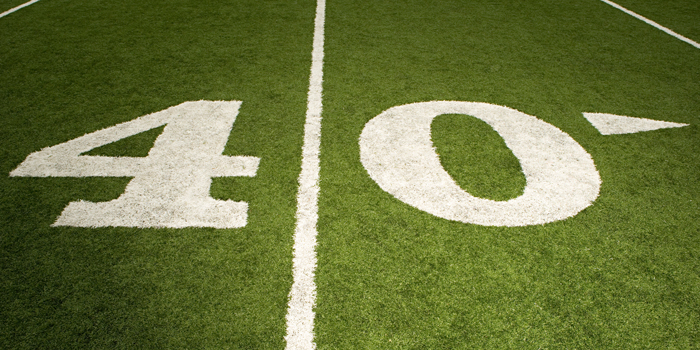
As we go into another combine season, we will watch as athletes jump, sprint, and perform agility and strength tests on national television on the NFL Network in hopes of gaining a larger paycheck and playing professional football. Last year we broke down the NFL 225 test as a result of some of the studies we have done on the subject. This year I want to look at the 40-yard dash — the king event for many combine athletes as the test of speed.
The first thing we need to take into account is the origin of the 40-yard dash. Why are they running 40 yards? How often do people run 40 yards in football? Not very often. The origins come from a coach looking to select athletes to be the runners for their punt team. Their punter had an average of a 40-yard kick, so they wanted to find the two guys who could run the 40 the fastest. They’d put those two on the field in the strategic position to be able to run down the field to make the tackle before the receiver could make moves to improve field position.
Now every athlete runs the 40, but why? Offensive and defensive linemen will run 40 yards in a blue moon, and there are probably no occurrences when the athlete will have to run 40 unimpeded yards during actual live play. So why even test it?
MORE: 225 Bench Press Repetitions Test — What Are We Really Testing?
Well, we test it because it’s not a bad test at all if you dig deeper. We simply need to look at things in a more specific manner. We have all seen the time splits, which are the 10, 20, and then 40 (you can get a 30 split as well, but I’ve never seen it). By looking at these in greater detail, we can gain more information. We’ll talk about what these times mean and what positions it may be most appropriate for.
The 10
The 10 would be most specific for groups that run short distances, so offensive and defensive line (specifically the tackles on defense). The 10 shows how fast you can get off of the ball and go 10 yards, and this will be about the maximal distance a lineman runs during a play. The 10 has also been found to be greatly affected by improvements in relative strength in the squat. If someone is strong, they do better in the 10 in rapidly overcoming their body from the stance. Typically, the people who are slowest here have a deficit of relative strength (relative strength is strength per unit of bodyweight). Most typically you see improvements in 10 times with improvement of relative strength up to a double bodyweight squat. Once that is surpassed, the practitioner most often does not see improvements in 10 times.
The 20
The 20 would be most relevant for groups that run middle distances such as linebackers, tight ends, power running backs, full backs and sometimes defensive ends (if they’re more of rushers than gap fillers). According to Boo Schexnayder, you work your clean to improve your 10-20 split. It requires great amounts of explosive strength to put force into the ground and overcome your own inertia. I will say that you must constantly focus on and reinforce technique for the clean. Often times the athlete will alter their strategy to be able to lift more weight on the clean, and this doesn’t lead to improvements in the 40 or elsewhere in athletic movements, as has been demonstrated in many of my VBT lectures.
The 40
The 40 would be most specific for the receivers, the defensive backs, speed running backs, and possibly those on special teams (the original group that this test was derived for). Top end speed is necessary to have the best performance and has been linked to success in football for those speed positions. Boo would tell you that this is sprint mechanics. If you did everything else right to improve the 10 and 20, the decreased ground contact times lead to just sprint mechanics and application of force in the appropriate vector. With the accumulated momentum, the athlete has to be strong enough to maintain their posture and have great technique to continue their top end speed. Things that would most effect this beyond sprint mechanics would be overspeed training, if appropriately applied.
Is the 40 a great test and very specific? Yes and no. If you’re looking for who to put on special teams (kickoff and punt specifically) then it is a fantastic test. It’s a decent test for receivers and defensive backs, but the 40 time alone is poor for all other positions. If we look at specific splits for the various positions, we may have a better idea of success. Additionally, by looking at the split times, and the changes in these split times as a result of training, we increase the information provided and improve our ability to give exercise prescriptions. If the start is slow, get stronger in the squat per unit of bodyweight (either maintain strength and lose bodyweight or just get stronger). If the 10-20 time is poor, and the 10 is good, then improve the power clean strength. If the 10 and 20 are great but 40 is poor (which doesn’t happen very often), work on sprint mechanics and possibly overspeed training. We can get greater info by going deeper, but that doesn’t mean that it’s the best test for everything.











2 Comments